Want to keep your garden buzzing with life instead of pests? Start with neem oil treatments, a natural pest repellent, and try a spicy garlic and chili pepper spray for a kick! Don’t forget the wonders of companion planting—marigolds and basil are your new best buds! Sprinkle diatomaceous earth for a crunchy barrier, and use physical barriers like row covers to shield your plants. Stay tuned to discover even more exciting and eco-friendly techniques for a thriving garden!
Neem Oil Treatment
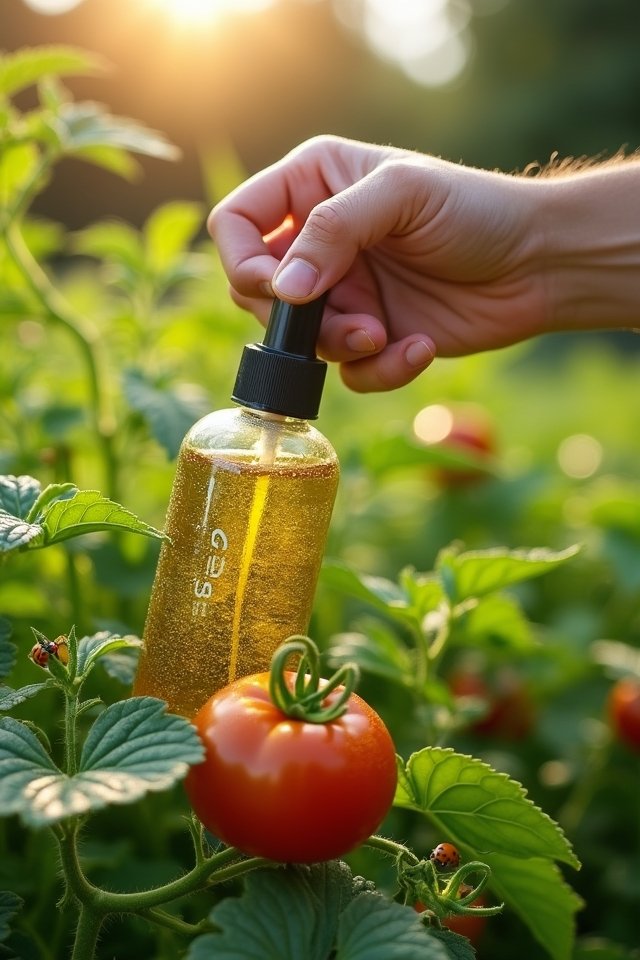
When it comes to defending your garden against pesky pests, neem oil is like having a superhero in your corner! This natural wonder offers incredible neem oil benefits, like repelling unwanted insects while keeping your plants safe. You’ll love how easy neem oil application is; just mix it with water, shake it well, and spray it on your plants!
Imagine your tomatoes, adorned in glorious red, thriving while aphids and spider mites scatter like scared mice! You can even use it as a preventative measure—feel like an eco-friendly guru! Just don’t let it sit in the sun too long; you’ll want to maintain its magical powers! Celebrate that vibrant, thriving garden, knowing neem oil’s got your back!
Soap Spray Solutions
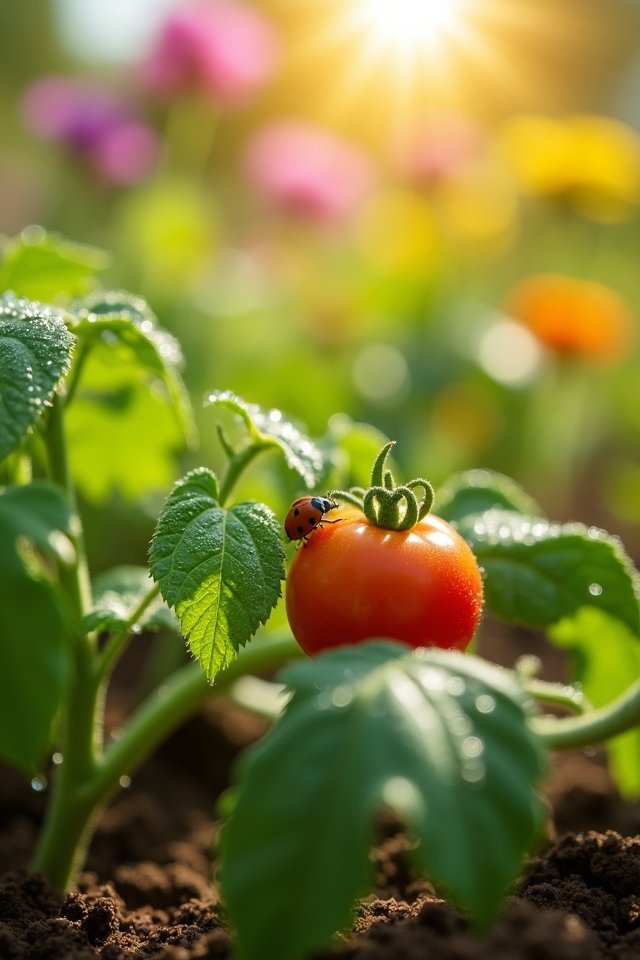
Get ready to blast those garden pests away with soap spray solutions! This eco-friendly method harnesses the potent soap efficacy to create a fantastic pest deterrence. Imagine this: a gentle yet fierce soap mix coats those annoying aphids and spider mites, smothering them like they’re caught in a fluffy cloud! Just mix one tablespoon of liquid soap with a quart of water, shake it up, and spray away. It’s like giving your plants their own cozy armor! This simple blend not only wipes out pests but also keeps diseases at bay. Who knew that a little soap could do so much? So, grab that spray bottle, and let the good times roll! Your garden will thank you—for real!
Diatomaceous Earth Application
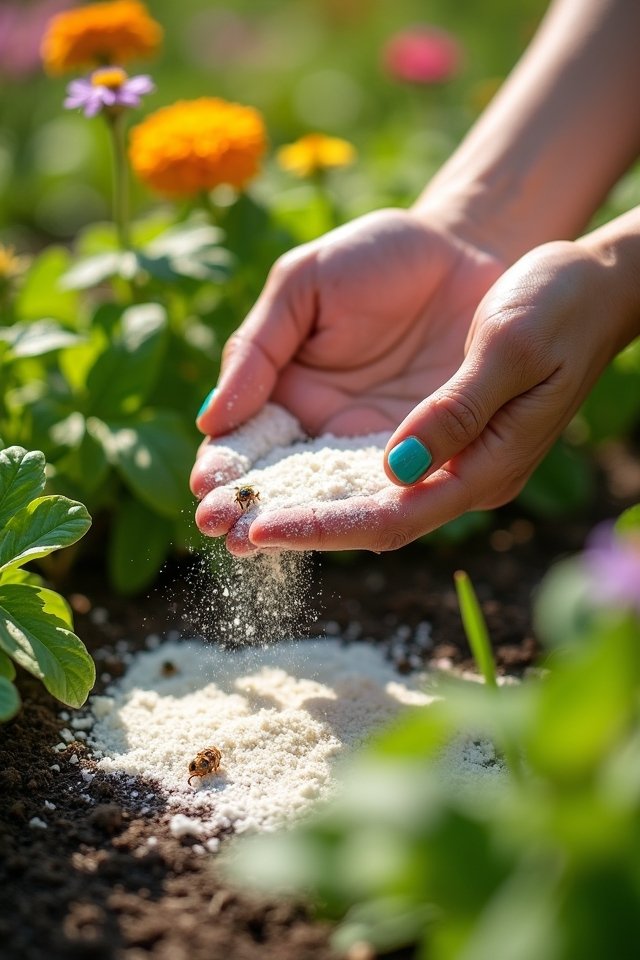
After you’ve pampered your plants with that delightful soap spray, why not give them another layer of protection? Enter diatomaceous earth, your garden’s secret armor! This natural powder, made from fossilized algae, has incredible diatomaceous earth benefits. When you sprinkle it around your plants, it’s like laying down a microscopic minefield for pests. They won’t know what hit them!
For ideal diatomaceous earth application, dust it on dry leaves and soil, ensuring even coverage. Be brave—don’t hold back! Just remember, moisture diminishes its power, so save this tactic for sunny days. You’ll love the scratchy surprise it gives those sneaky insects. Your plants deserve this boost, and with a sprinkle of this magic dust, you’re their superhero!
Companion Planting Techniques
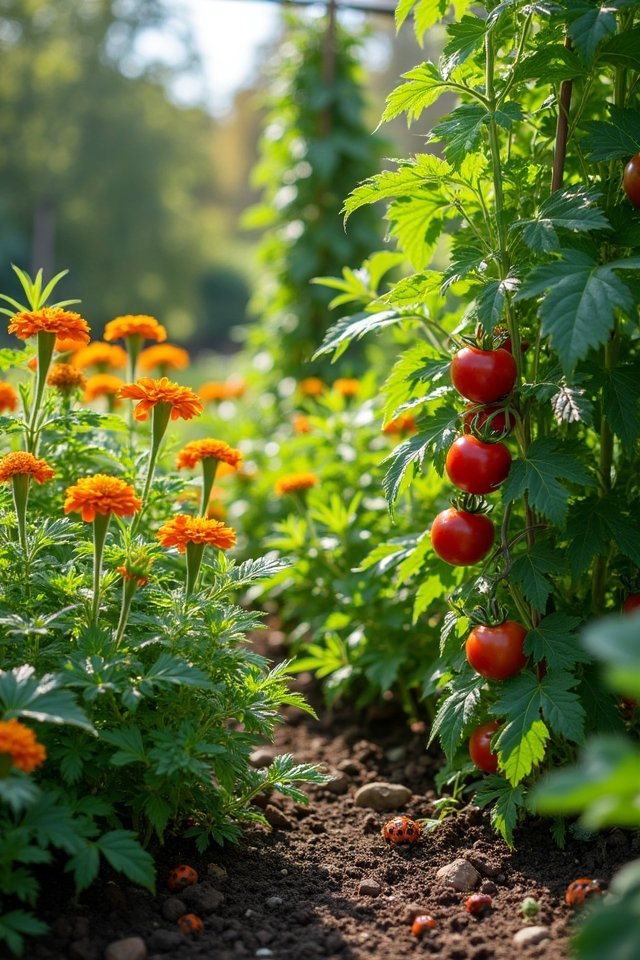
Have you ever noticed how some plants just get along famously, while others seem to squabble like siblings? In gardening, this is known as companion planting! By mixing different plants, you can create a natural harmony that boosts growth, deters pests, and enhances flavors. Think of tomatoes and basil; together they’re like a dynamic duo, fighting off pests and tasting incredible in your dishes! Crop rotation also plays into this technique, as it helps maintain soil health and encourage plant diversity. You could pair carrots with onions, too—these buddies confuse pests, making your garden a fortress of flavors! So, experiment with combinations and watch your garden thrive—like a party for plants that just keep getting better!
Garlic and Chili Pepper Spray
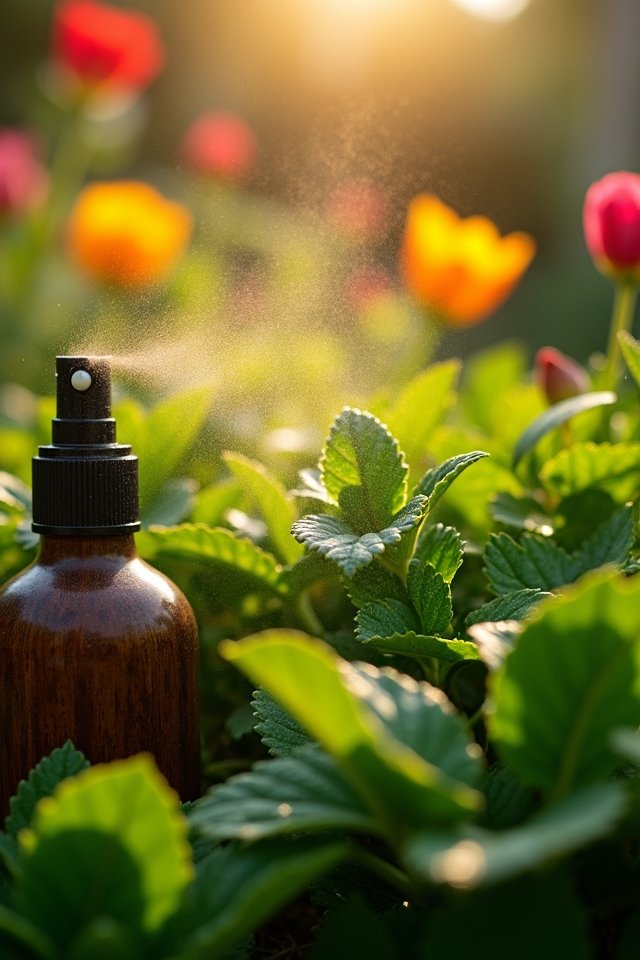
Imagine stepping into your garden, where the air is filled with the delightful scents of fresh herbs and vibrant vegetables! Now, picture whipping up a game-changer in pest control: a garlic and chili pepper spray. Not only do garlic benefits include repelling pesky insects, but it also lends a fragrant kick to your garden’s ecosystem! When you mix chili pepper effectiveness into the potion, you create a fiery deterrent that pests can’t stand—think of it as your garden’s superhero duo. Simply blend garlic cloves and chili peppers with water, strain it, and spray away! You’ll be the proud guardian of your green space, keeping munching monsters at bay while enjoying the sweet aroma of innovation! Isn’t that cool?
Beneficial Insects Introduction
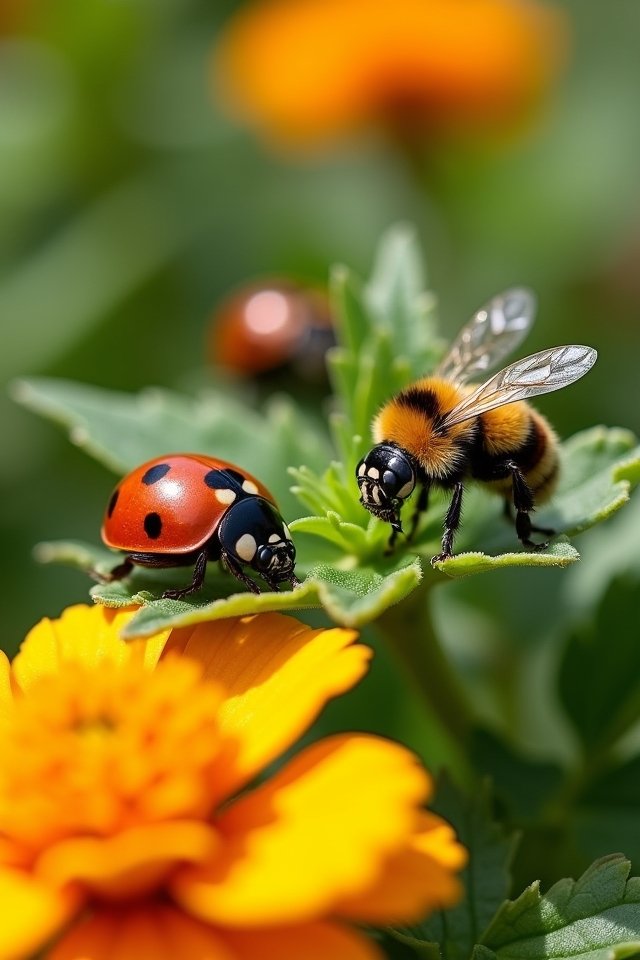
While your garlic and chili pepper spray works its magic, you might be surprised to learn that there’s another army ready to support your garden defense! Enter the heroic cast of beneficial insects—think ladybugs, lacewings, and parasitic wasps. These tiny allies thrive on pests that threaten your plants, like aphids and caterpillars, allowing your garden to flourish in delightful harmony.
Incorporating insect diversity not only controls pests but also highlights pollinator importance! Imagine your flowers blooming with vibrant colors, as bees and butterflies waltz around, spreading joy and life. By creating a welcoming habitat—like adding nectar-rich flowers or water sources—you’ll enhance your garden’s resilience. So, gear up! With beneficial insects at your side, pest control becomes less of a chore and more of a garden party!
Organic Mulching Practices
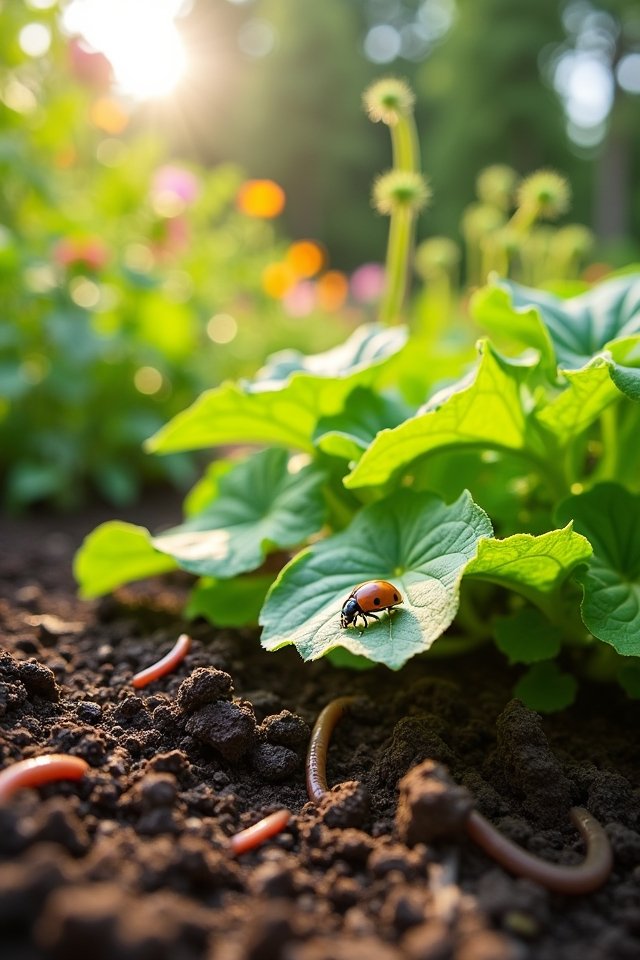
When you’re looking to nurture your garden, organic mulching practices can be a game changer! Imagine a cozy blanket of organic materials hugging your plants, keeping them warm and happy. By using mulch layering, you not only suppress pesky weeds, but also retain moisture in your soil—perfect for those sunny days!
Think about using shredded leaves, straw, or even wood chips. They break down over time, enriching your soil like a feast for happy earthworms. Plus, who doesn’t want a vibrant garden that’s less prone to pests? Covering your beds with these natural wonders breathing life into your garden—one layer at a time! So grab those organic goodies and immerse yourself in this lush, nourishing world of mulching—your plants will thank you!
Fruits and Vegetable Natural Repellents
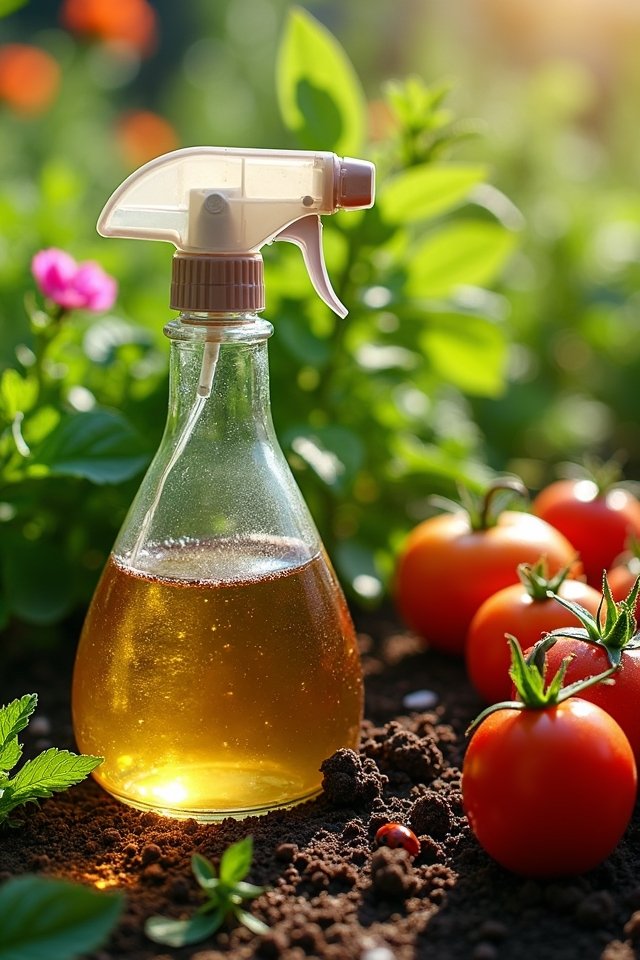
Fruits and vegetables can be your garden’s best friends when it comes to natural pest control! Imagine using citrus peels to deter pesky insects, or planting marigolds alongside your crops to keep those critters at bay. Citrus acts like a scent shield—who knew oranges could be such clever fruit repellents? Plus, consider the mighty garlic! Its pungent aroma serves as powerful vegetable deterrents against unwelcome guests. Even mint can be a sneaky ally, warding off aphids while adding a fresh aroma to the air. Why not experiment with these delightful goodies? You’ll not only protect your garden but might just inspire the neighbors with your innovative, eco-friendly approach. Plus, nothing says garden like the scent of fresh plants and fruits mingling together!
Essential Oils for Pest Management
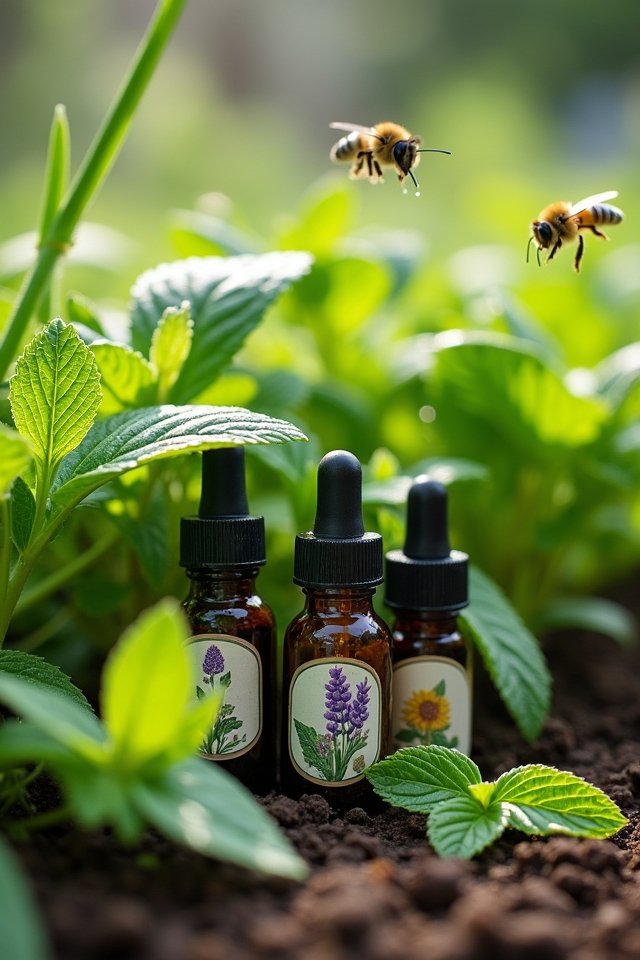
You might not realize it, but essential oils can be your garden’s secret weapon in the battle against bugs! These potent treasures pack a punch with their pest repellent properties, making your garden a less-than-ideal spot for pesky intruders. Why not give them a try? Here are a few essential oil blends to contemplate:
- Peppermint: A sharp, invigorating scent that mice and ants can’t stand!
- Tea Tree: Known for its antifungal powers, it also deters unwanted pests.
- Cedarwood: Its woodsy aroma keeps moths and beetles at bay.
- Lavender: Not just calming for you, but offensive to flies!
- Lemongrass: Its citrusy fragrance is delightful for you, but a big “no thanks” for bugs!
Get ready to welcome the power of nature!
Physical Barriers and Traps
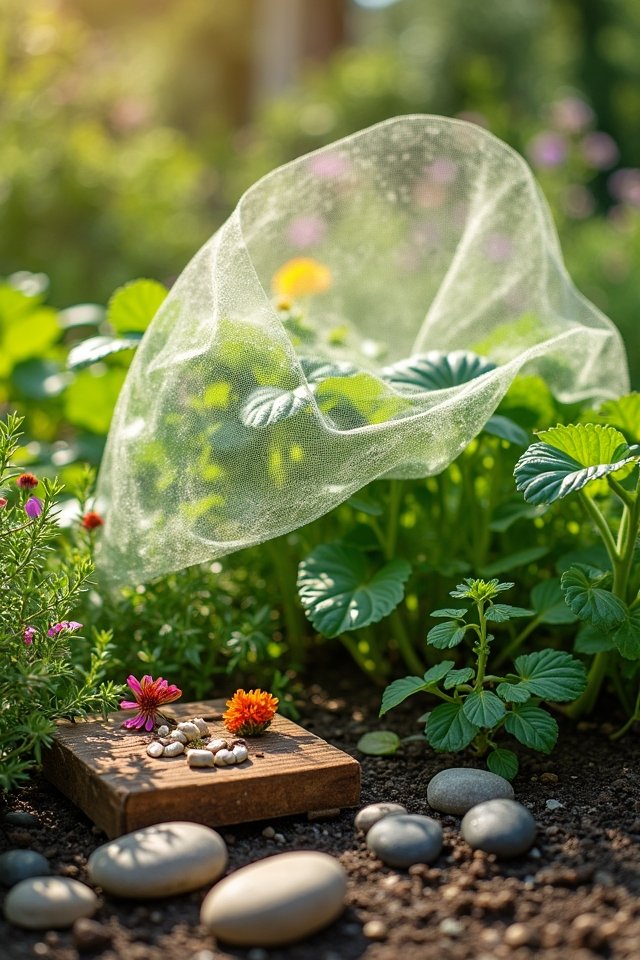
As pests invade your garden like uninvited party crashers, it’s time to roll out the welcome mat for physical barriers and traps! You’ll love using row covers; they act like little protective tents that shield your plants from pesky insects. Imagine your precious seedlings tucked safely under soft fabric, thriving away from danger!
Sticky traps, on the other hand, are your vigilant bouncers, catching those sneaky intruders. Place them around your garden, and watch as bugs stick around a little longer than they intended! Whether it’s keeps bugs at bay or stops them in their tracks, these innovative methods not only protect your plants but also turn pest control into a fun challenge. Welcome creativity and safeguard your garden!
Frequently Asked Questions
How Often Should I Apply Organic Pest Control Methods?
When it comes to application frequency for pest control, think of it like dating—staying consistent is key! You’ll want to adjust your timing based on the pest lifecycle. For instance, if you spot those sneaky aphids, apply your remedy every 7 to 14 days. This keeps your garden buzzing with life instead of pests! Don’t forget to monitor closely; it’s all about finding the right rhythm to maintain a happy, healthy garden!
Are Organic Pest Control Methods Safe for Pets and Children?
You might think organic pest control isn’t safe for your furry friends or little ones, but that’s a common misconception! Many natural repellents, like neem oil or diatomaceous earth, are pet-safe and child-friendly. Just picture your pet frolicking happily in a bug-free garden, basking in sunshine! Always apply these wonders according to guidelines, and you’ll create a safe haven. Why worry when nature offers such brilliant solutions? Your garden can blossom, and so can your family’s fun!
Can I Mix Different Organic Pest Control Methods Together?
Absolutely, you can mix different organic pest control methods together! It’s like brewing a secret potion for your garden. Combining techniques can create synergistic effects, making them even more powerful together! For example, try blending neem oil with diatomaceous earth—it’s like a superhero duo against pests! Just remember to test small areas first, so you don’t accidentally start a pest party instead! Experiment and watch your garden thrive—it’s science in action!
How Do I Store Leftover Homemade Pest Control Solutions?
Running out of space in your homemade storage, eh? It’s like trying to fit a hippo in a teacup! To store leftover pest control solutions, pour them into airtight containers—think mason jars! Label them, so you remember what’s inside. Ideally, keep them cool and dark to boost solution longevity. And hey, if it starts smelling like your gym socks, toss it! Your garden will appreciate the fresh, sweet-smelling alternatives!
What Signs Indicate That My Pest Control Method Is Working?
You’ll know your pest control method’s working when you see changes in pest behavior! If those pesky little critters start disappearing or seem sluggish, that’s a great sign. Keep an eye out for healthy plants and fresh growth; it’s like nature’s applause for your efforts. Treatment results shine when you spot fewer holes in leaves—just like that delicious gift from your hard work! Isn’t it exciting to watch your garden thrive?


